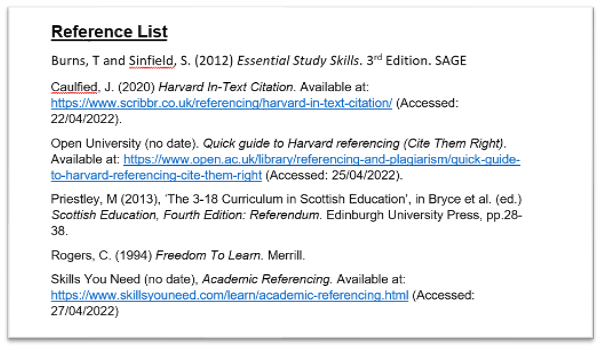Study Skills : Referencing
What is referencing?
When you are doing an essay or a report, your writing will include sources
of information such as articles, policies, books, research or theories. Referencing is the way to refer to these sources, showing where
the things you are writing about come from.
Why do I need to do referencing?
- It acknowledges other people’s work that you have used in your essay or report
- It shows to your marker that you have done your reading
- Your writing will be stronger if it is backed up with references to previous articles, policies, books, research or theories
- If you don’t use references, you may be taking other people’s ideas and presenting them as your own. This is called plagiarism and is a serious academic offence
When should I put in a reference?
| Quoting directly from a source of information? | Yes |
| Writing about a source of information? | Yes |
| Summing up someone else’s ideas or theories? | Yes |
| Writing about common knowledge or your ideas? | No |
So, how do I do it?
At Dumfries & Galloway College, the type of referencing that is used is called Harvard referencing. It can seem a bit confusing to begin with. But once you go through this guide – and some of the links below – you’ll soon get your head round it!
Harvard referencing is made up of two main elements: a reference list and in-text references…
In-Text References
When you quote directly from a source of information, you need to make an in-text reference. For a direct quote, the in-text reference should include: the author’s surname, the date of publication and the page number. This information should be put in brackets after the quote. Here is an example:
In terms of the most important elements of the Curriculum for Excellence, “a major theme is flexibility” (Priestly, 2013, P.30).
When you want to refer to a source of information, but not quote from it directly, you should place an in-text reference (with author’s surname and date of publication) where you refer to it in your essay. An example of this is:
The approaches used by the nursery staff help the young people to meet the Curriculum for Excellence aims (Education Scotland, 2016).
In this example, the person writing this is showing that the Curriculum for Excellence aims are published in a document written by Education Scotland in the year 2016. As we see here, the author can be one person, more than one or an organisation.
If you can’t find a date of publication for the document, just write “no date” (or “n.d.” for short) after the author’s name.
For a bigger list of examples, have a look at this online guide – Harvard In-Text Citation
Importantly, don’t leave your referencing to the end. Write down your sources of information as you go!
An in-text reference only gives so much information (author and date). This is where the second part of referencing comes in – the reference list…
Reference List
At the end of your essay or report you will make a reference list. This is a list of the references you have used. These references are called full references
How to reference a book…
Format for full reference: Author surname, initial. (Year of publication) Book title. Publisher.
Example of full reference: Rogers, C. (1994) Freedom To Learn. Merrill.
How to reference a website…
Format for full reference: Author surname, initial. (Year that the webpage was published or last updated) Title of web page. Available at: web address. (Accessed: date).
Example of full reference: Caulfield, J. (2020) Harvard In-Text Citation. Available at: https://www.scribbr.co.uk/referencing/harvard-in-text-citation/ (Accessed: 22/04/2022)
For a bigger list of how to reference different online sources of information, read this harvard website reference guide
Once you have all your full references, then arrange them at the end of the main section of your essay or report in alphabetical order based on the author’s surname. Here is an example of what a reference list looks like…

Download / More Information
You can download this guide as a PDF below or you can click the link to read more of our Study Guides.